Corporate Governance: Shareholders, Stakeholders, and Board Decisions
VerifiedAdded on 2023/06/09
|12
|2313
|132
Report
AI Summary
This report delves into the core principles of corporate governance, focusing on the distinctions between shareholders and stakeholders. It begins by defining these key terms, highlighting the differing influences and impacts each group exerts on a business. The report then argues for the primacy of shareholders, emphasizing their role as investors and owners, whose financial contributions are essential for organizational operations. It explores the various roles shareholders play, from financing and operational oversight to control and setting regulations. Furthermore, the report provides recommendations on how a board of directors can make more effective decisions, particularly focusing on performance assessment, risk management frameworks, and the crucial process of key decision-making. The conclusion reinforces the importance of prioritizing shareholders while acknowledging the interconnectedness of all stakeholders within the corporate structure.
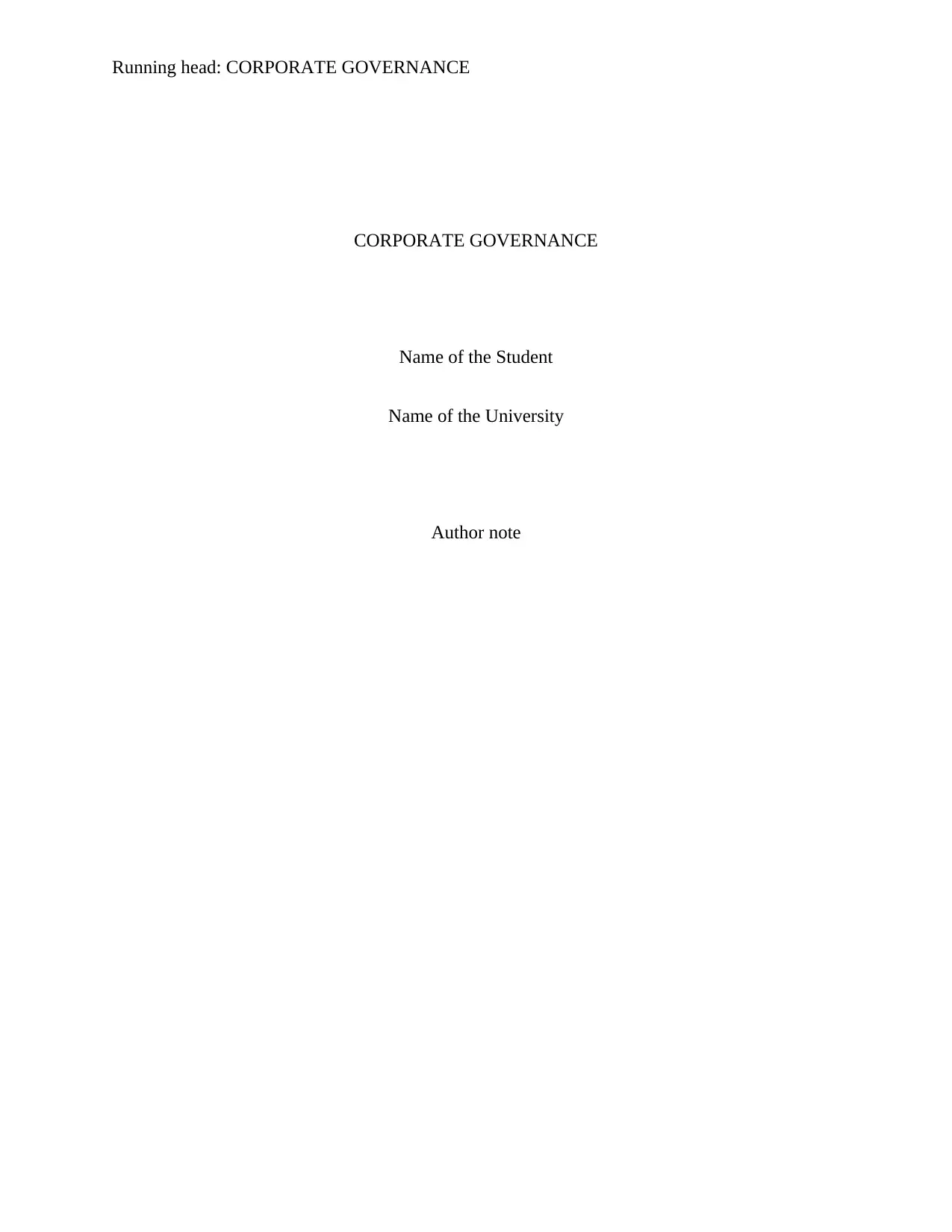
Running head: CORPORATE GOVERNANCE
CORPORATE GOVERNANCE
Name of the Student
Name of the University
Author note
CORPORATE GOVERNANCE
Name of the Student
Name of the University
Author note
Paraphrase This Document
Need a fresh take? Get an instant paraphrase of this document with our AI Paraphraser
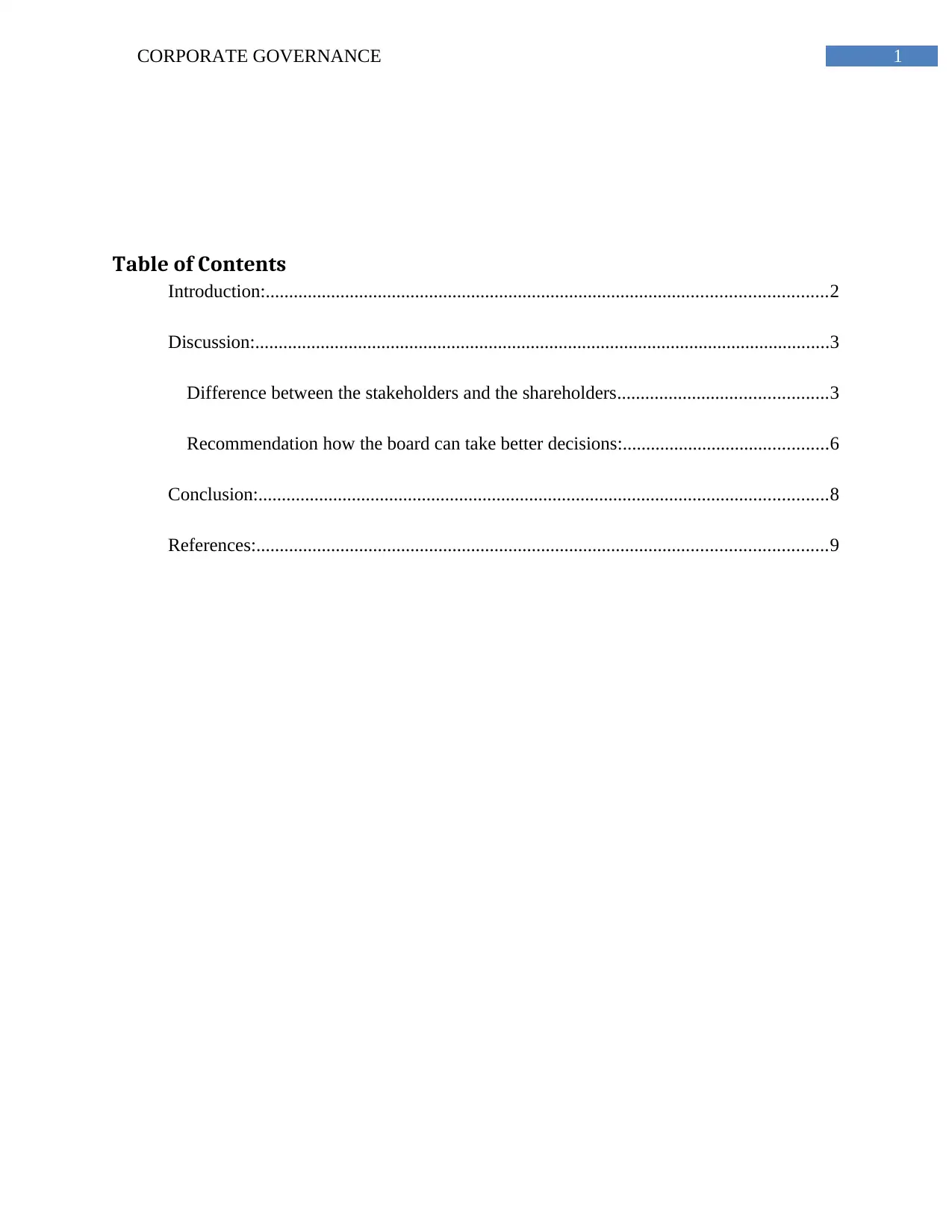
1CORPORATE GOVERNANCE
Table of Contents
Introduction:........................................................................................................................2
Discussion:...........................................................................................................................3
Difference between the stakeholders and the shareholders.............................................3
Recommendation how the board can take better decisions:............................................6
Conclusion:..........................................................................................................................8
References:..........................................................................................................................9
Table of Contents
Introduction:........................................................................................................................2
Discussion:...........................................................................................................................3
Difference between the stakeholders and the shareholders.............................................3
Recommendation how the board can take better decisions:............................................6
Conclusion:..........................................................................................................................8
References:..........................................................................................................................9
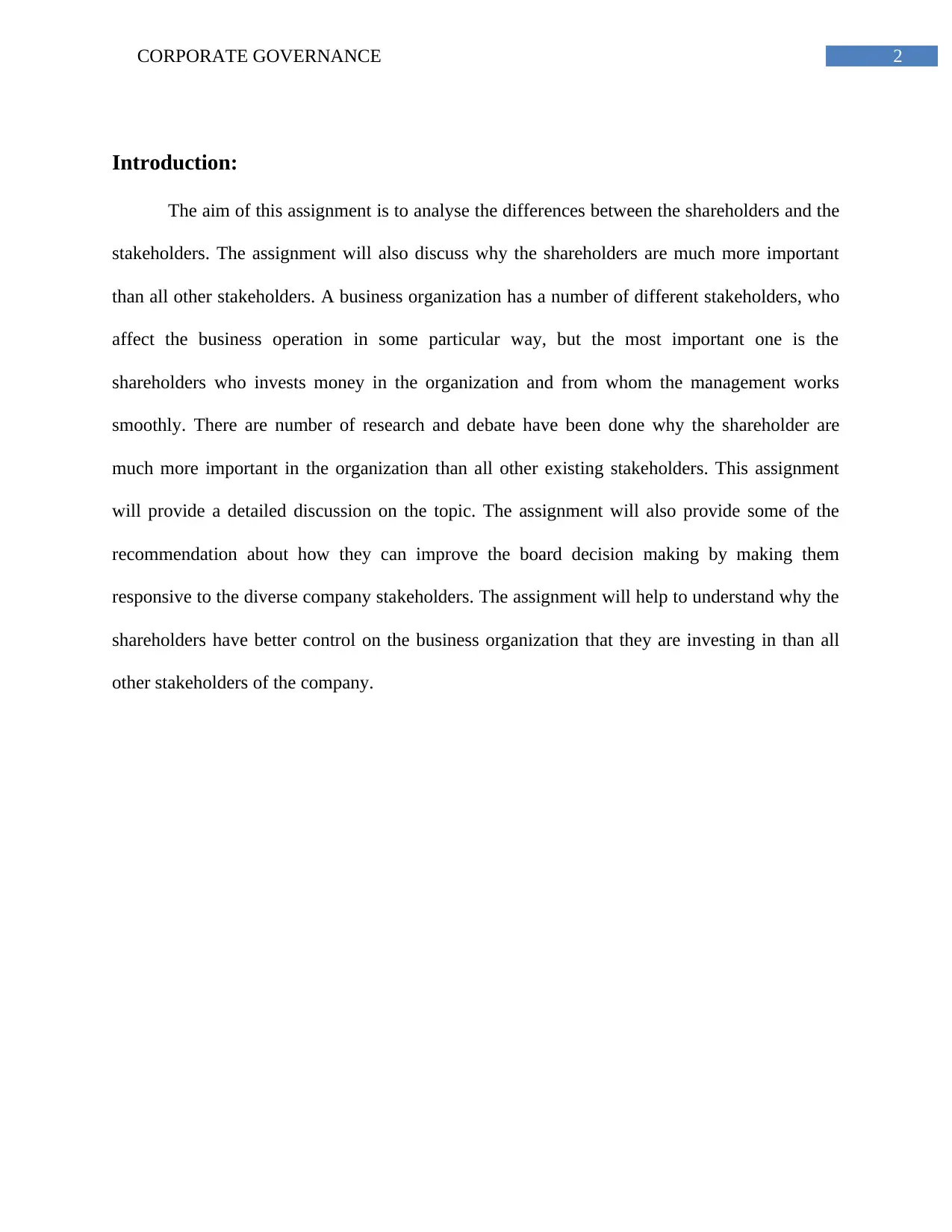
2CORPORATE GOVERNANCE
Introduction:
The aim of this assignment is to analyse the differences between the shareholders and the
stakeholders. The assignment will also discuss why the shareholders are much more important
than all other stakeholders. A business organization has a number of different stakeholders, who
affect the business operation in some particular way, but the most important one is the
shareholders who invests money in the organization and from whom the management works
smoothly. There are number of research and debate have been done why the shareholder are
much more important in the organization than all other existing stakeholders. This assignment
will provide a detailed discussion on the topic. The assignment will also provide some of the
recommendation about how they can improve the board decision making by making them
responsive to the diverse company stakeholders. The assignment will help to understand why the
shareholders have better control on the business organization that they are investing in than all
other stakeholders of the company.
Introduction:
The aim of this assignment is to analyse the differences between the shareholders and the
stakeholders. The assignment will also discuss why the shareholders are much more important
than all other stakeholders. A business organization has a number of different stakeholders, who
affect the business operation in some particular way, but the most important one is the
shareholders who invests money in the organization and from whom the management works
smoothly. There are number of research and debate have been done why the shareholder are
much more important in the organization than all other existing stakeholders. This assignment
will provide a detailed discussion on the topic. The assignment will also provide some of the
recommendation about how they can improve the board decision making by making them
responsive to the diverse company stakeholders. The assignment will help to understand why the
shareholders have better control on the business organization that they are investing in than all
other stakeholders of the company.
⊘ This is a preview!⊘
Do you want full access?
Subscribe today to unlock all pages.

Trusted by 1+ million students worldwide
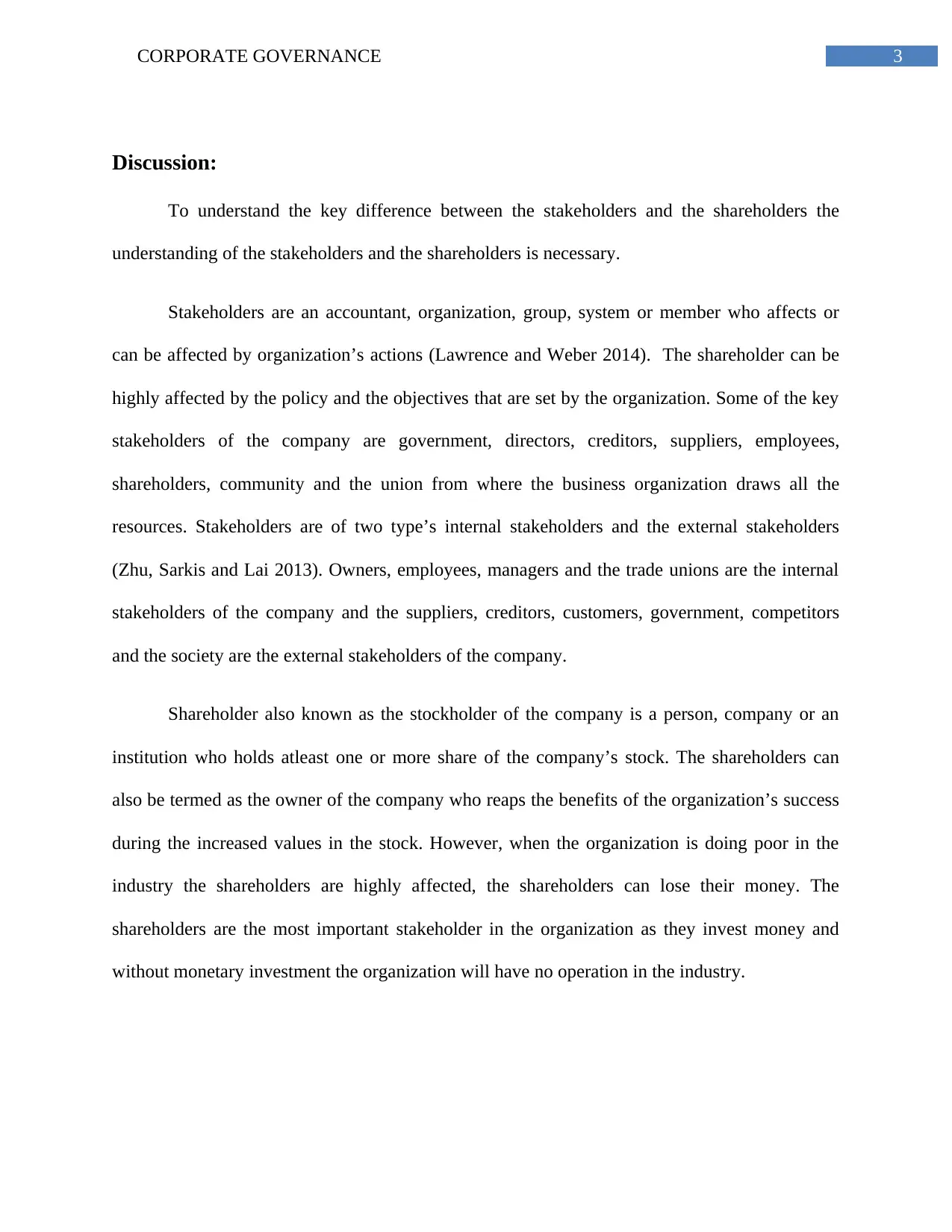
3CORPORATE GOVERNANCE
Discussion:
To understand the key difference between the stakeholders and the shareholders the
understanding of the stakeholders and the shareholders is necessary.
Stakeholders are an accountant, organization, group, system or member who affects or
can be affected by organization’s actions (Lawrence and Weber 2014). The shareholder can be
highly affected by the policy and the objectives that are set by the organization. Some of the key
stakeholders of the company are government, directors, creditors, suppliers, employees,
shareholders, community and the union from where the business organization draws all the
resources. Stakeholders are of two type’s internal stakeholders and the external stakeholders
(Zhu, Sarkis and Lai 2013). Owners, employees, managers and the trade unions are the internal
stakeholders of the company and the suppliers, creditors, customers, government, competitors
and the society are the external stakeholders of the company.
Shareholder also known as the stockholder of the company is a person, company or an
institution who holds atleast one or more share of the company’s stock. The shareholders can
also be termed as the owner of the company who reaps the benefits of the organization’s success
during the increased values in the stock. However, when the organization is doing poor in the
industry the shareholders are highly affected, the shareholders can lose their money. The
shareholders are the most important stakeholder in the organization as they invest money and
without monetary investment the organization will have no operation in the industry.
Discussion:
To understand the key difference between the stakeholders and the shareholders the
understanding of the stakeholders and the shareholders is necessary.
Stakeholders are an accountant, organization, group, system or member who affects or
can be affected by organization’s actions (Lawrence and Weber 2014). The shareholder can be
highly affected by the policy and the objectives that are set by the organization. Some of the key
stakeholders of the company are government, directors, creditors, suppliers, employees,
shareholders, community and the union from where the business organization draws all the
resources. Stakeholders are of two type’s internal stakeholders and the external stakeholders
(Zhu, Sarkis and Lai 2013). Owners, employees, managers and the trade unions are the internal
stakeholders of the company and the suppliers, creditors, customers, government, competitors
and the society are the external stakeholders of the company.
Shareholder also known as the stockholder of the company is a person, company or an
institution who holds atleast one or more share of the company’s stock. The shareholders can
also be termed as the owner of the company who reaps the benefits of the organization’s success
during the increased values in the stock. However, when the organization is doing poor in the
industry the shareholders are highly affected, the shareholders can lose their money. The
shareholders are the most important stakeholder in the organization as they invest money and
without monetary investment the organization will have no operation in the industry.
Paraphrase This Document
Need a fresh take? Get an instant paraphrase of this document with our AI Paraphraser
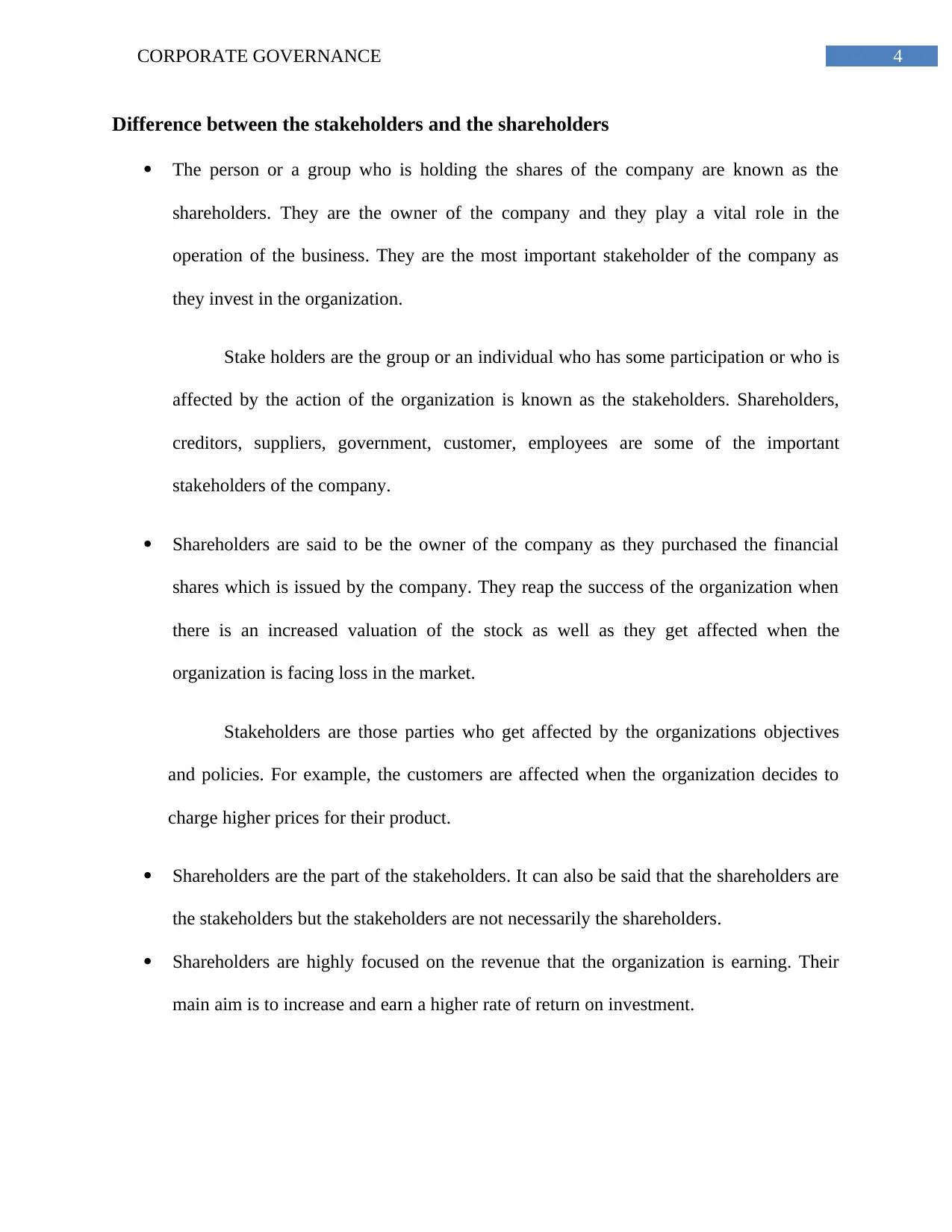
4CORPORATE GOVERNANCE
Difference between the stakeholders and the shareholders
The person or a group who is holding the shares of the company are known as the
shareholders. They are the owner of the company and they play a vital role in the
operation of the business. They are the most important stakeholder of the company as
they invest in the organization.
Stake holders are the group or an individual who has some participation or who is
affected by the action of the organization is known as the stakeholders. Shareholders,
creditors, suppliers, government, customer, employees are some of the important
stakeholders of the company.
Shareholders are said to be the owner of the company as they purchased the financial
shares which is issued by the company. They reap the success of the organization when
there is an increased valuation of the stock as well as they get affected when the
organization is facing loss in the market.
Stakeholders are those parties who get affected by the organizations objectives
and policies. For example, the customers are affected when the organization decides to
charge higher prices for their product.
Shareholders are the part of the stakeholders. It can also be said that the shareholders are
the stakeholders but the stakeholders are not necessarily the shareholders.
Shareholders are highly focused on the revenue that the organization is earning. Their
main aim is to increase and earn a higher rate of return on investment.
Difference between the stakeholders and the shareholders
The person or a group who is holding the shares of the company are known as the
shareholders. They are the owner of the company and they play a vital role in the
operation of the business. They are the most important stakeholder of the company as
they invest in the organization.
Stake holders are the group or an individual who has some participation or who is
affected by the action of the organization is known as the stakeholders. Shareholders,
creditors, suppliers, government, customer, employees are some of the important
stakeholders of the company.
Shareholders are said to be the owner of the company as they purchased the financial
shares which is issued by the company. They reap the success of the organization when
there is an increased valuation of the stock as well as they get affected when the
organization is facing loss in the market.
Stakeholders are those parties who get affected by the organizations objectives
and policies. For example, the customers are affected when the organization decides to
charge higher prices for their product.
Shareholders are the part of the stakeholders. It can also be said that the shareholders are
the stakeholders but the stakeholders are not necessarily the shareholders.
Shareholders are highly focused on the revenue that the organization is earning. Their
main aim is to increase and earn a higher rate of return on investment.
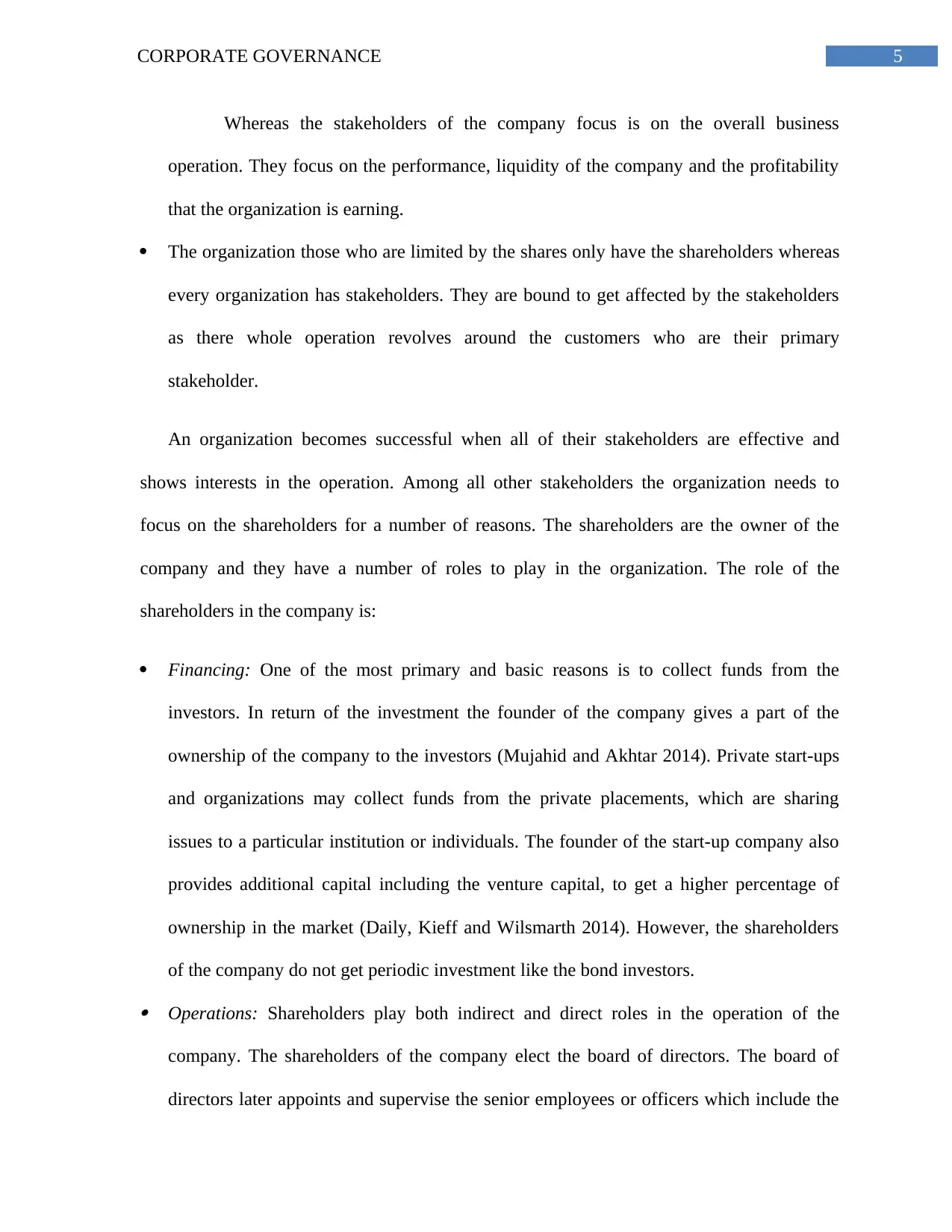
5CORPORATE GOVERNANCE
Whereas the stakeholders of the company focus is on the overall business
operation. They focus on the performance, liquidity of the company and the profitability
that the organization is earning.
The organization those who are limited by the shares only have the shareholders whereas
every organization has stakeholders. They are bound to get affected by the stakeholders
as there whole operation revolves around the customers who are their primary
stakeholder.
An organization becomes successful when all of their stakeholders are effective and
shows interests in the operation. Among all other stakeholders the organization needs to
focus on the shareholders for a number of reasons. The shareholders are the owner of the
company and they have a number of roles to play in the organization. The role of the
shareholders in the company is:
Financing: One of the most primary and basic reasons is to collect funds from the
investors. In return of the investment the founder of the company gives a part of the
ownership of the company to the investors (Mujahid and Akhtar 2014). Private start-ups
and organizations may collect funds from the private placements, which are sharing
issues to a particular institution or individuals. The founder of the start-up company also
provides additional capital including the venture capital, to get a higher percentage of
ownership in the market (Daily, Kieff and Wilsmarth 2014). However, the shareholders
of the company do not get periodic investment like the bond investors. Operations: Shareholders play both indirect and direct roles in the operation of the
company. The shareholders of the company elect the board of directors. The board of
directors later appoints and supervise the senior employees or officers which include the
Whereas the stakeholders of the company focus is on the overall business
operation. They focus on the performance, liquidity of the company and the profitability
that the organization is earning.
The organization those who are limited by the shares only have the shareholders whereas
every organization has stakeholders. They are bound to get affected by the stakeholders
as there whole operation revolves around the customers who are their primary
stakeholder.
An organization becomes successful when all of their stakeholders are effective and
shows interests in the operation. Among all other stakeholders the organization needs to
focus on the shareholders for a number of reasons. The shareholders are the owner of the
company and they have a number of roles to play in the organization. The role of the
shareholders in the company is:
Financing: One of the most primary and basic reasons is to collect funds from the
investors. In return of the investment the founder of the company gives a part of the
ownership of the company to the investors (Mujahid and Akhtar 2014). Private start-ups
and organizations may collect funds from the private placements, which are sharing
issues to a particular institution or individuals. The founder of the start-up company also
provides additional capital including the venture capital, to get a higher percentage of
ownership in the market (Daily, Kieff and Wilsmarth 2014). However, the shareholders
of the company do not get periodic investment like the bond investors. Operations: Shareholders play both indirect and direct roles in the operation of the
company. The shareholders of the company elect the board of directors. The board of
directors later appoints and supervise the senior employees or officers which include the
⊘ This is a preview!⊘
Do you want full access?
Subscribe today to unlock all pages.

Trusted by 1+ million students worldwide
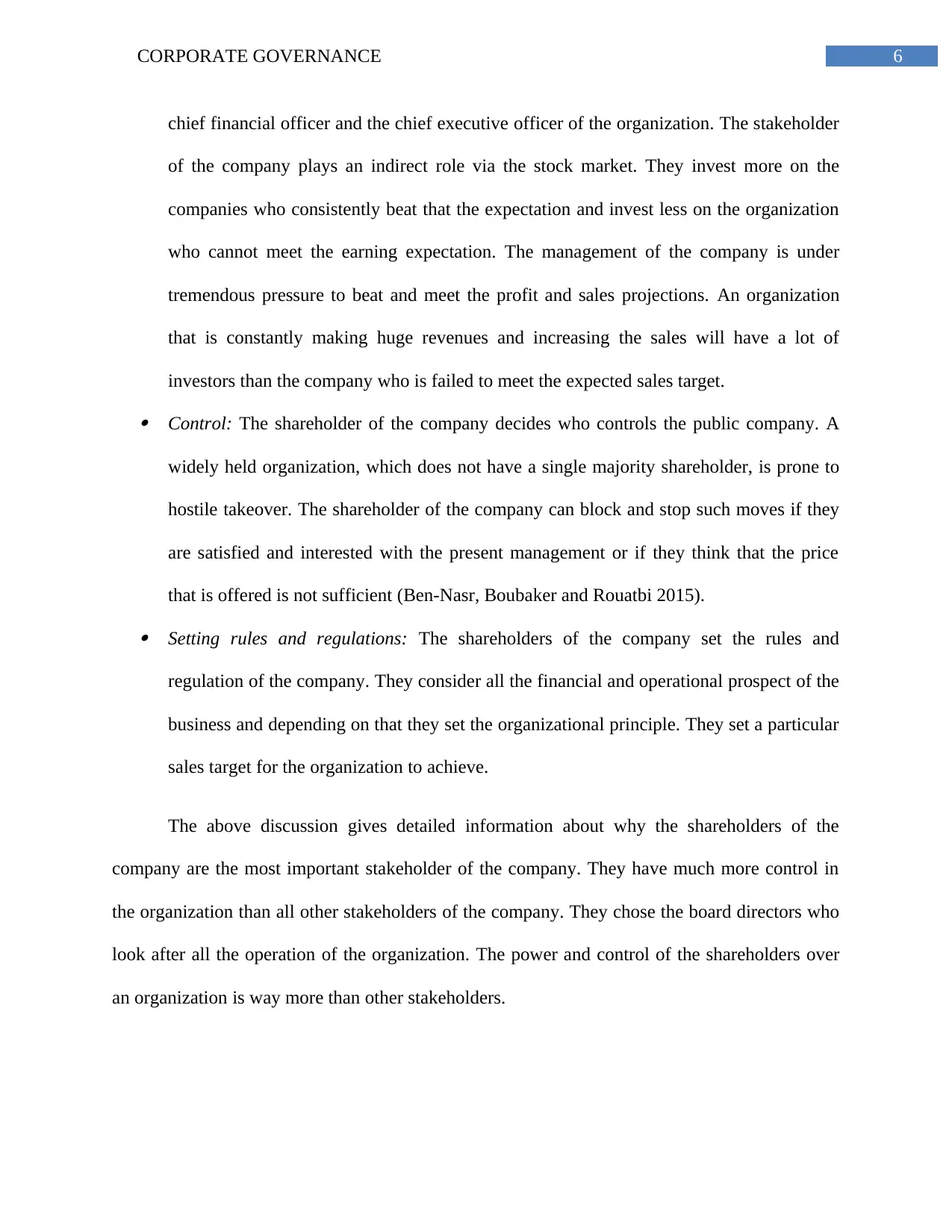
6CORPORATE GOVERNANCE
chief financial officer and the chief executive officer of the organization. The stakeholder
of the company plays an indirect role via the stock market. They invest more on the
companies who consistently beat that the expectation and invest less on the organization
who cannot meet the earning expectation. The management of the company is under
tremendous pressure to beat and meet the profit and sales projections. An organization
that is constantly making huge revenues and increasing the sales will have a lot of
investors than the company who is failed to meet the expected sales target. Control: The shareholder of the company decides who controls the public company. A
widely held organization, which does not have a single majority shareholder, is prone to
hostile takeover. The shareholder of the company can block and stop such moves if they
are satisfied and interested with the present management or if they think that the price
that is offered is not sufficient (Ben-Nasr, Boubaker and Rouatbi 2015). Setting rules and regulations: The shareholders of the company set the rules and
regulation of the company. They consider all the financial and operational prospect of the
business and depending on that they set the organizational principle. They set a particular
sales target for the organization to achieve.
The above discussion gives detailed information about why the shareholders of the
company are the most important stakeholder of the company. They have much more control in
the organization than all other stakeholders of the company. They chose the board directors who
look after all the operation of the organization. The power and control of the shareholders over
an organization is way more than other stakeholders.
chief financial officer and the chief executive officer of the organization. The stakeholder
of the company plays an indirect role via the stock market. They invest more on the
companies who consistently beat that the expectation and invest less on the organization
who cannot meet the earning expectation. The management of the company is under
tremendous pressure to beat and meet the profit and sales projections. An organization
that is constantly making huge revenues and increasing the sales will have a lot of
investors than the company who is failed to meet the expected sales target. Control: The shareholder of the company decides who controls the public company. A
widely held organization, which does not have a single majority shareholder, is prone to
hostile takeover. The shareholder of the company can block and stop such moves if they
are satisfied and interested with the present management or if they think that the price
that is offered is not sufficient (Ben-Nasr, Boubaker and Rouatbi 2015). Setting rules and regulations: The shareholders of the company set the rules and
regulation of the company. They consider all the financial and operational prospect of the
business and depending on that they set the organizational principle. They set a particular
sales target for the organization to achieve.
The above discussion gives detailed information about why the shareholders of the
company are the most important stakeholder of the company. They have much more control in
the organization than all other stakeholders of the company. They chose the board directors who
look after all the operation of the organization. The power and control of the shareholders over
an organization is way more than other stakeholders.
Paraphrase This Document
Need a fresh take? Get an instant paraphrase of this document with our AI Paraphraser
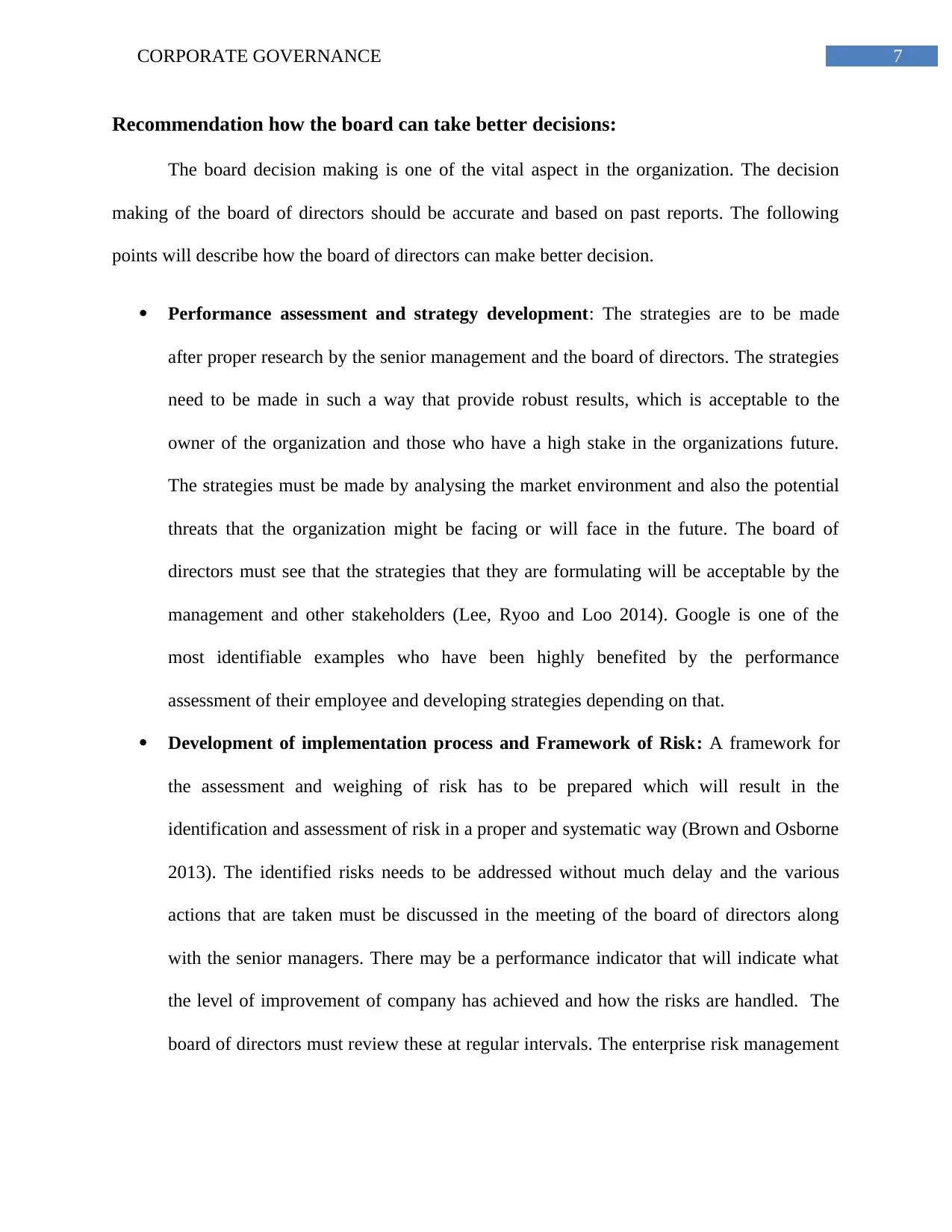
7CORPORATE GOVERNANCE
Recommendation how the board can take better decisions:
The board decision making is one of the vital aspect in the organization. The decision
making of the board of directors should be accurate and based on past reports. The following
points will describe how the board of directors can make better decision.
Performance assessment and strategy development: The strategies are to be made
after proper research by the senior management and the board of directors. The strategies
need to be made in such a way that provide robust results, which is acceptable to the
owner of the organization and those who have a high stake in the organizations future.
The strategies must be made by analysing the market environment and also the potential
threats that the organization might be facing or will face in the future. The board of
directors must see that the strategies that they are formulating will be acceptable by the
management and other stakeholders (Lee, Ryoo and Loo 2014). Google is one of the
most identifiable examples who have been highly benefited by the performance
assessment of their employee and developing strategies depending on that.
Development of implementation process and Framework of Risk: A framework for
the assessment and weighing of risk has to be prepared which will result in the
identification and assessment of risk in a proper and systematic way (Brown and Osborne
2013). The identified risks needs to be addressed without much delay and the various
actions that are taken must be discussed in the meeting of the board of directors along
with the senior managers. There may be a performance indicator that will indicate what
the level of improvement of company has achieved and how the risks are handled. The
board of directors must review these at regular intervals. The enterprise risk management
Recommendation how the board can take better decisions:
The board decision making is one of the vital aspect in the organization. The decision
making of the board of directors should be accurate and based on past reports. The following
points will describe how the board of directors can make better decision.
Performance assessment and strategy development: The strategies are to be made
after proper research by the senior management and the board of directors. The strategies
need to be made in such a way that provide robust results, which is acceptable to the
owner of the organization and those who have a high stake in the organizations future.
The strategies must be made by analysing the market environment and also the potential
threats that the organization might be facing or will face in the future. The board of
directors must see that the strategies that they are formulating will be acceptable by the
management and other stakeholders (Lee, Ryoo and Loo 2014). Google is one of the
most identifiable examples who have been highly benefited by the performance
assessment of their employee and developing strategies depending on that.
Development of implementation process and Framework of Risk: A framework for
the assessment and weighing of risk has to be prepared which will result in the
identification and assessment of risk in a proper and systematic way (Brown and Osborne
2013). The identified risks needs to be addressed without much delay and the various
actions that are taken must be discussed in the meeting of the board of directors along
with the senior managers. There may be a performance indicator that will indicate what
the level of improvement of company has achieved and how the risks are handled. The
board of directors must review these at regular intervals. The enterprise risk management
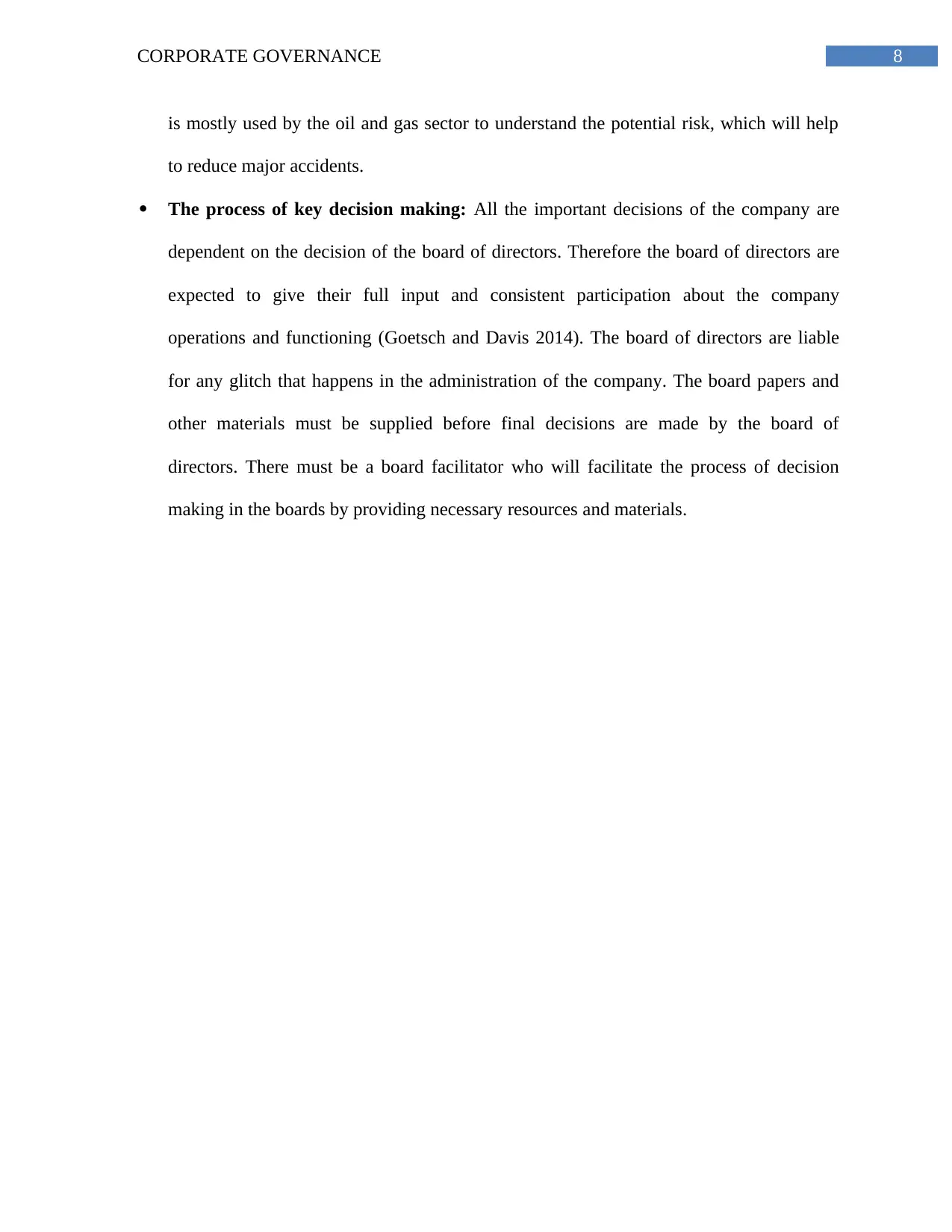
8CORPORATE GOVERNANCE
is mostly used by the oil and gas sector to understand the potential risk, which will help
to reduce major accidents.
The process of key decision making: All the important decisions of the company are
dependent on the decision of the board of directors. Therefore the board of directors are
expected to give their full input and consistent participation about the company
operations and functioning (Goetsch and Davis 2014). The board of directors are liable
for any glitch that happens in the administration of the company. The board papers and
other materials must be supplied before final decisions are made by the board of
directors. There must be a board facilitator who will facilitate the process of decision
making in the boards by providing necessary resources and materials.
is mostly used by the oil and gas sector to understand the potential risk, which will help
to reduce major accidents.
The process of key decision making: All the important decisions of the company are
dependent on the decision of the board of directors. Therefore the board of directors are
expected to give their full input and consistent participation about the company
operations and functioning (Goetsch and Davis 2014). The board of directors are liable
for any glitch that happens in the administration of the company. The board papers and
other materials must be supplied before final decisions are made by the board of
directors. There must be a board facilitator who will facilitate the process of decision
making in the boards by providing necessary resources and materials.
⊘ This is a preview!⊘
Do you want full access?
Subscribe today to unlock all pages.

Trusted by 1+ million students worldwide
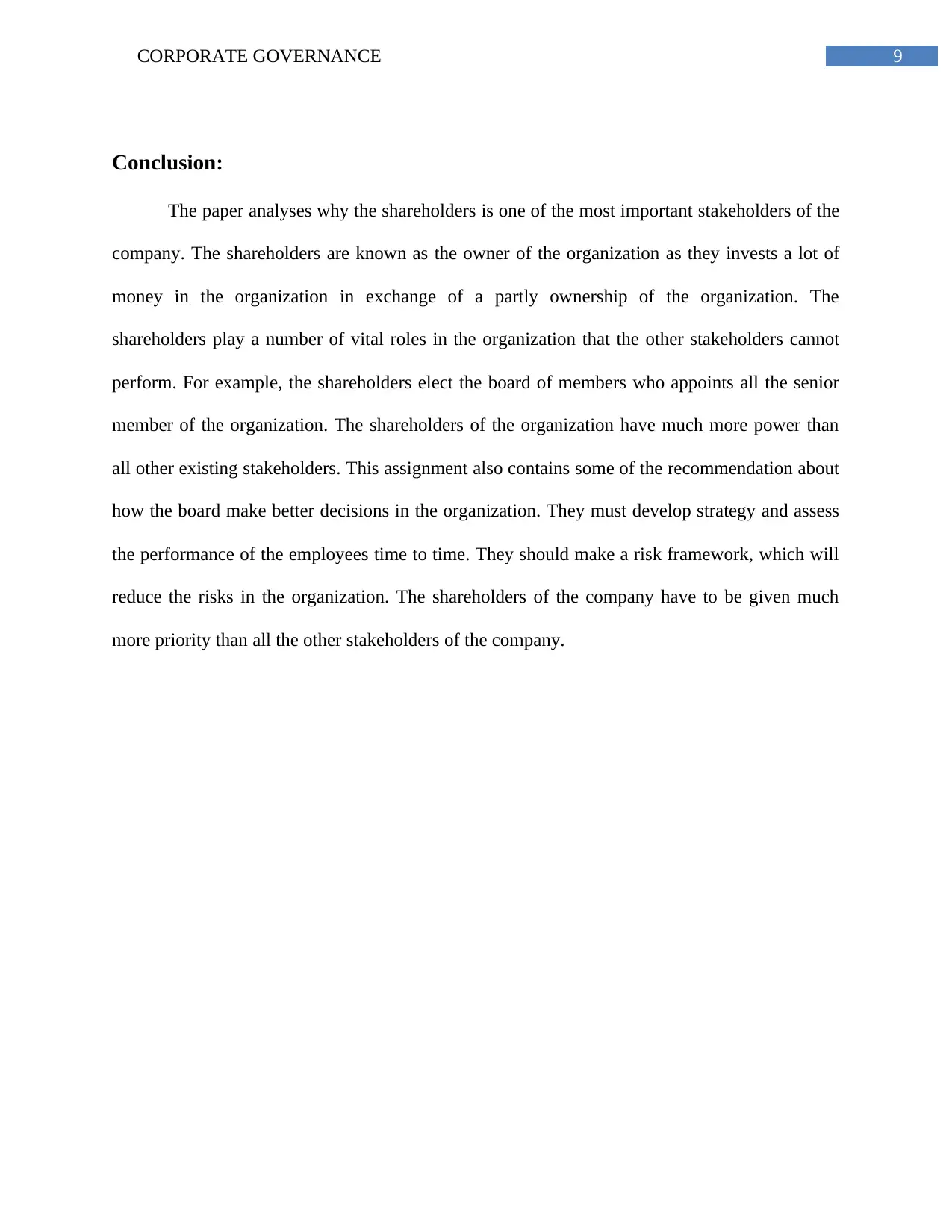
9CORPORATE GOVERNANCE
Conclusion:
The paper analyses why the shareholders is one of the most important stakeholders of the
company. The shareholders are known as the owner of the organization as they invests a lot of
money in the organization in exchange of a partly ownership of the organization. The
shareholders play a number of vital roles in the organization that the other stakeholders cannot
perform. For example, the shareholders elect the board of members who appoints all the senior
member of the organization. The shareholders of the organization have much more power than
all other existing stakeholders. This assignment also contains some of the recommendation about
how the board make better decisions in the organization. They must develop strategy and assess
the performance of the employees time to time. They should make a risk framework, which will
reduce the risks in the organization. The shareholders of the company have to be given much
more priority than all the other stakeholders of the company.
Conclusion:
The paper analyses why the shareholders is one of the most important stakeholders of the
company. The shareholders are known as the owner of the organization as they invests a lot of
money in the organization in exchange of a partly ownership of the organization. The
shareholders play a number of vital roles in the organization that the other stakeholders cannot
perform. For example, the shareholders elect the board of members who appoints all the senior
member of the organization. The shareholders of the organization have much more power than
all other existing stakeholders. This assignment also contains some of the recommendation about
how the board make better decisions in the organization. They must develop strategy and assess
the performance of the employees time to time. They should make a risk framework, which will
reduce the risks in the organization. The shareholders of the company have to be given much
more priority than all the other stakeholders of the company.
Paraphrase This Document
Need a fresh take? Get an instant paraphrase of this document with our AI Paraphraser
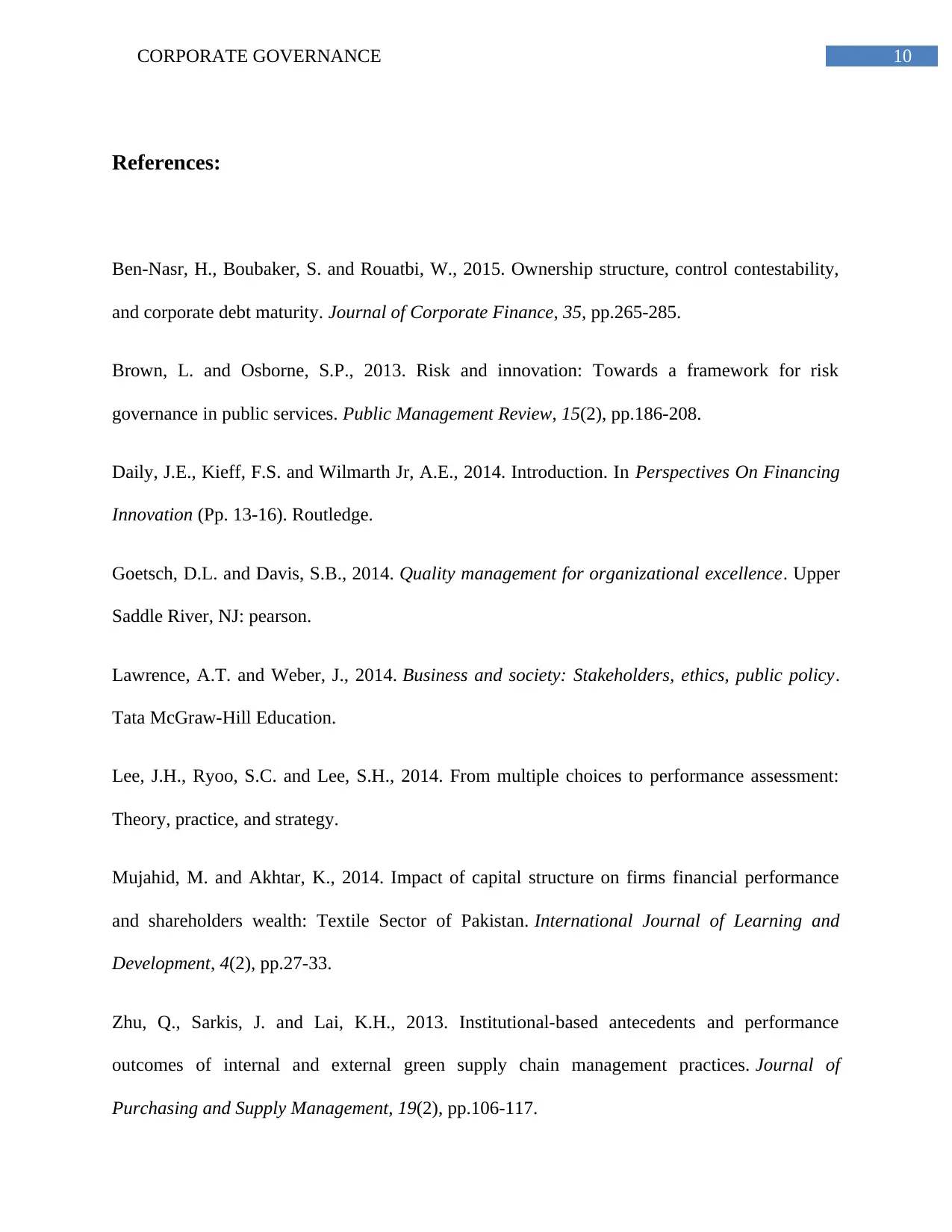
10CORPORATE GOVERNANCE
References:
Ben-Nasr, H., Boubaker, S. and Rouatbi, W., 2015. Ownership structure, control contestability,
and corporate debt maturity. Journal of Corporate Finance, 35, pp.265-285.
Brown, L. and Osborne, S.P., 2013. Risk and innovation: Towards a framework for risk
governance in public services. Public Management Review, 15(2), pp.186-208.
Daily, J.E., Kieff, F.S. and Wilmarth Jr, A.E., 2014. Introduction. In Perspectives On Financing
Innovation (Pp. 13-16). Routledge.
Goetsch, D.L. and Davis, S.B., 2014. Quality management for organizational excellence. Upper
Saddle River, NJ: pearson.
Lawrence, A.T. and Weber, J., 2014. Business and society: Stakeholders, ethics, public policy.
Tata McGraw-Hill Education.
Lee, J.H., Ryoo, S.C. and Lee, S.H., 2014. From multiple choices to performance assessment:
Theory, practice, and strategy.
Mujahid, M. and Akhtar, K., 2014. Impact of capital structure on firms financial performance
and shareholders wealth: Textile Sector of Pakistan. International Journal of Learning and
Development, 4(2), pp.27-33.
Zhu, Q., Sarkis, J. and Lai, K.H., 2013. Institutional-based antecedents and performance
outcomes of internal and external green supply chain management practices. Journal of
Purchasing and Supply Management, 19(2), pp.106-117.
References:
Ben-Nasr, H., Boubaker, S. and Rouatbi, W., 2015. Ownership structure, control contestability,
and corporate debt maturity. Journal of Corporate Finance, 35, pp.265-285.
Brown, L. and Osborne, S.P., 2013. Risk and innovation: Towards a framework for risk
governance in public services. Public Management Review, 15(2), pp.186-208.
Daily, J.E., Kieff, F.S. and Wilmarth Jr, A.E., 2014. Introduction. In Perspectives On Financing
Innovation (Pp. 13-16). Routledge.
Goetsch, D.L. and Davis, S.B., 2014. Quality management for organizational excellence. Upper
Saddle River, NJ: pearson.
Lawrence, A.T. and Weber, J., 2014. Business and society: Stakeholders, ethics, public policy.
Tata McGraw-Hill Education.
Lee, J.H., Ryoo, S.C. and Lee, S.H., 2014. From multiple choices to performance assessment:
Theory, practice, and strategy.
Mujahid, M. and Akhtar, K., 2014. Impact of capital structure on firms financial performance
and shareholders wealth: Textile Sector of Pakistan. International Journal of Learning and
Development, 4(2), pp.27-33.
Zhu, Q., Sarkis, J. and Lai, K.H., 2013. Institutional-based antecedents and performance
outcomes of internal and external green supply chain management practices. Journal of
Purchasing and Supply Management, 19(2), pp.106-117.
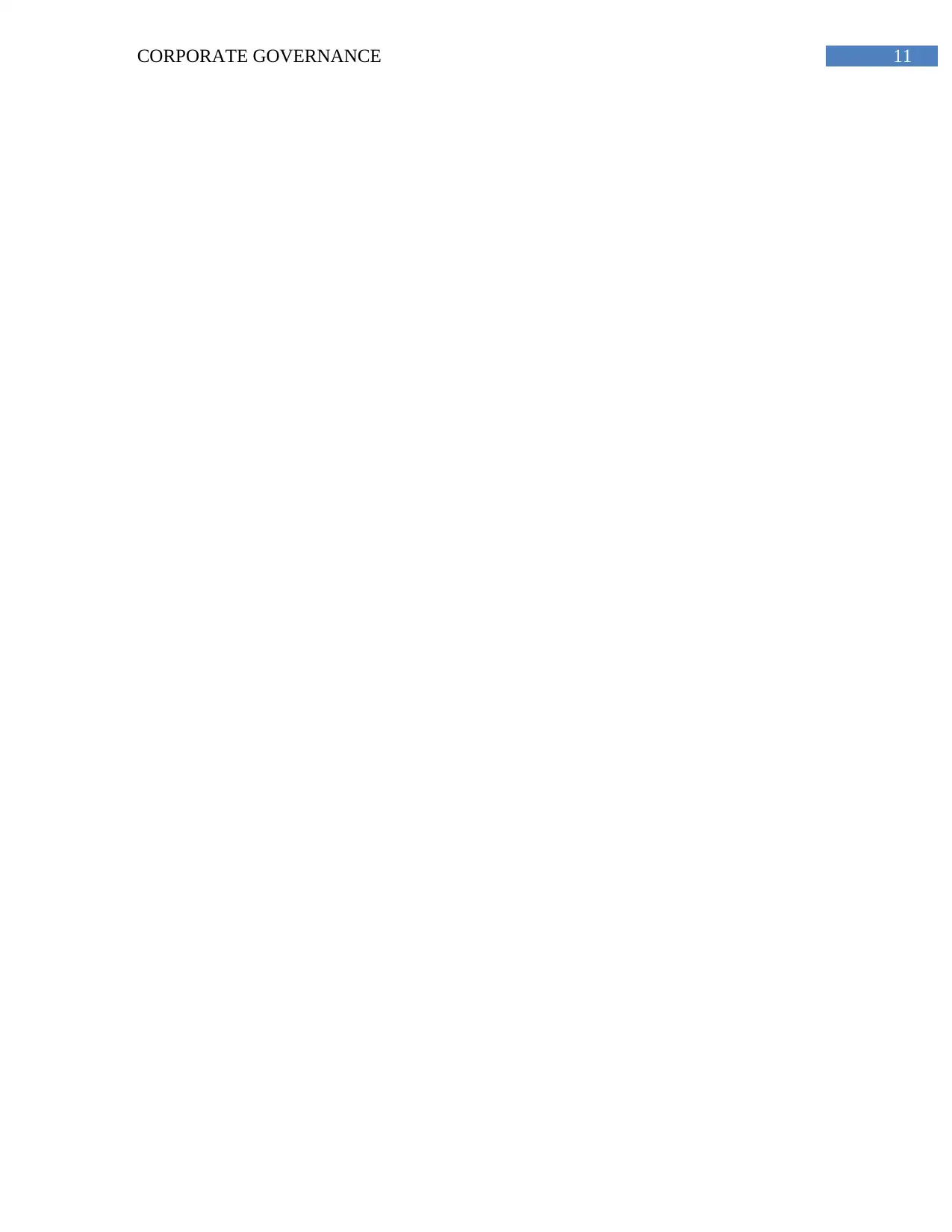
11CORPORATE GOVERNANCE
⊘ This is a preview!⊘
Do you want full access?
Subscribe today to unlock all pages.

Trusted by 1+ million students worldwide
1 out of 12
Related Documents
Your All-in-One AI-Powered Toolkit for Academic Success.
+13062052269
info@desklib.com
Available 24*7 on WhatsApp / Email
![[object Object]](/_next/static/media/star-bottom.7253800d.svg)
Unlock your academic potential
Copyright © 2020–2025 A2Z Services. All Rights Reserved. Developed and managed by ZUCOL.




